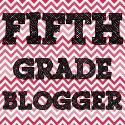
Moving into week three of the Reading in the Wild book study that Catherine from The Brown Bag Teacher started. This week we are focusing on chapter 2, "Wild Readers Self-Select Reading Material" and our fabulous hosts for this section are A Teacher's Treasure and Making it as a Middle School Teacher. Head on over to their blog for some of their insight on the chapter.
Donalyn Miller discusses the importance of teachers recognizing that students must learn how to choose books for themselves. In doing so, it fosters engagement and increases their reading motivation and interest. Miller suggests a few different types of community conversations (read alouds, creating a book buzz, abandoning books, guess my lexile, the mature shelf, selection reflection, preview stacks, and keeping track of reading life) that can help with students learning how to self-select their reading material.
Community Conversations (pages 47-78)
Read Alouds
I will tell you first hand that 5th graders (any upper grade students) still love and enjoy read alouds! Each trimester, I choose a read aloud that goes well with our theme and during my ELA block, I fit in 10 minutes for a read aloud. More often than not, my students are begging me to continue on with the reading. It is so awesome! I also strategically choose read alouds that are part of a series. I figure if the read aloud gets the students interested, they will more likely want to pick up the sequel or any other book by the same author.
Miller states the following benefits of read alouds (page 49-50):
- They build community.
- They expose our children to books, authors, or genres they might not discover on their own.
- They provide prime opportunities to introduce students to genres they often avoid, like poetry, biographies, and nonfiction.
- They support developing readers.
- They reinforce that reading is enjoyable.
- Choose books from authors who will lead your students to more books.
- Share a variety of texts, including nonfiction, poetry, and online articles.
- Consider time constraints and book length.
- Decide how students will view illustrations.
- Read books that you enjoy.
- Ditch the read aloud if it doesn't work.
Miller has some great reading community suggestions that I will be putting into play this year. I can see how it engages the students and gets them excited about reading and want to implement more of them this school year.
Millers reading community suggestions (53-56):
- Invite students to share their favorite read aloud.
- When you have a guest teacher, leave a read aloud different from the one you are already reading to the class.
- Participate in World Read Aloud Day.
- Invite students to select your next read aloud.
- Post a lists of the texts you have shared.
- Ask students to sign their favorite read aloud selections for the year.
Creating Book Buzz (56-58)
I love, love, love Miller's book buzz! She uses this as a way to introduce new books to students...books they may have not been interested in without some sort of endorsement. First she presents a book commercial in which she shares a short preview of the book, her personal thoughts on the book, etc. Students then add the book title to their Books to Read List and enter a drawing to read it. I think The Brown Bag Teacher has posts about doing book raffles in her classroom.
Abandoning Books (58-62)
Now this is something I have a hard time doing. I always tough it out, even if the book has lost its spark for me. I like how Miller suggests that it is ok to abandon a book that is boring, confusing, or poorly written. I think it is also important to let the students know that it is ok. I can see where sticking with a boring book can result in the student losing the joy in reading. I like that she gives a goal of abandoning it after reading 50 pages if it is uninteresting.
Guess My Lexile (62-63)
I agree with Miller, that assessing students' reading levels is helpful when determining reading ability and what books might fit them. But it is also important to let students choose books freely...they may have certain interests, preferences, background knowledge, or purpose for reading. I feel that if they choose a book that is beyond their ability, they will abandon the book and no harm was done.
The Mature Shelf (64-66)
Miller's mature shelf is genius! I am going to implement that in my classroom this year too. It is a shelf for students who read above grade level to choose books that will challenge and engage them.
Selection Reflections (66-70)
In this section, Miller shared her My Selection Reflection form that she has her students use to reflect upon the books they have selected and why.
Preview Stacks (71-74)
Another awesome idea that Miller has! She builds preview stacks for her students to help reinforce and support their self-selection efforts while tapping into your knowledge as a teacher of their reading interests. She has some great questions that she asks her students in order for her to build the preview stack: What genre do you want to read? What have you already looked at today? What was the last book you finished that you really liked? What sort of book are you thinking about? She then places a stack of books on that students desk.
Keeping Track of Your Reading Life (74-78)
Miller has her students keep track of their reading by documenting every book they read (she has a reading list form they fill out). I've done this in the past and it worked out really well. It is a great reflection piece for the student and it helps you as the teacher understand what their interests and struggles are.
WOW!! That was a lot of information! I know I bulleted a lot of the information, I really suggest that you purchase this book and her other book The Book Whisperer. These books have opened my eyes up to a lot of wonderful things!










I love how you bullet the information. I think I tend to focus on one thing too much and miss a lot!
ReplyDeleteMisty
Think, Wonder, & Teach
What a great idea to "strategically choose" read-alouds that are part of a series! What are some of the series you introduce to your fifth graders?
ReplyDeleteLast year I read the following chapter books as read alouds that were part of a series: Chains and City of Ember. I also read the following chapter books to introduce my kids to new authors in the hope they would read more books by them: Esperanza Rising, Maniac Magee, Number the Stars, and Fever 1776.
Delete